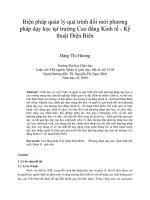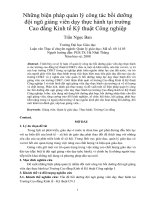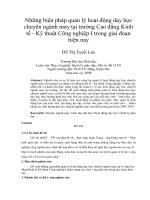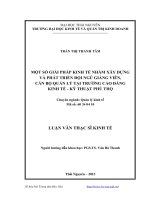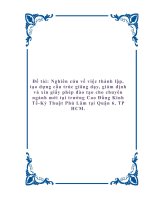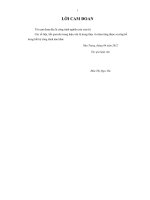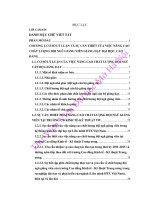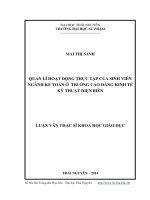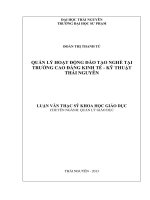Thái độ của sinh viên không chuyên đối với việc dạy đọc hiểu tiếng Anh chuyên ngành Điện tử tại trường Cao đẳng Kinh tế - Kỹ thuật
Bạn đang xem bản rút gọn của tài liệu. Xem và tải ngay bản đầy đủ của tài liệu tại đây (1.33 MB, 61 trang )
1
Vietnam national university, Hanoi
University of Languages and international studies
faculty of Post-graduate Studies
KIỀU THỊ THU HÀ
THE NON-MAJOR ENGLISH STUDENTS’ ATTITUDES TOWARDS THE
TEACHING OF ENGLISH IN ELECTRONICS READING AT HAI DUONG
COLLEGE OF ECONOMICS AND TECHNOLOGY
(Thái độ của sinh viên không chuyên đối với việc dạy đọc hiểu tiếng Anh
chuyên ngành Điện tử tại trƣờng Cao đẳng Kinh tế - Kỹ thuật Hải Dƣơng)
MA. MINOR THESIS
Field: English Teaching Methodology
Code: 60 14 10
Hanoi, 2010
2
Vietnam national university, Hanoi
University of Languages and international studies
faculty of Post-graduate Studies
KIỀU THỊ THU HÀ
THE NON-MAJOR ENGLISH STUDENTS’ ATTITUDES TOWARDS THE
TEACHING OF ENGLISH IN ELECTRONICS READING AT HAI DUONG
COLLEGE OF ECONOMICS AND TECHNOLOGY
(Thái độ của sinh viên không chuyên đối với việc dạy đọc hiểu tiếng Anh
chuyên ngành Điện tử tại trƣờng Cao đẳng Kinh tế - Kỹ thuật Hải Dƣơng)
MA. MINOR THESIS
Field: English Teaching Methodology
Code: 60 14 10
Cohort: MA 17
Supervisor: Phạm Minh Tâm, (M.Ed.)
Hanoi, 2010
5
LIST OF ABBREVIATIONS
HCET: Hai Duong College of Economics and Technology
GE: General English
ESP: English for Specific Purposes
EE: English in Electronics
6
LIST OF TABLES
Table 1: Students’ Attitude towards English in Electronics at HCET
Table 2: Students’ Awareness of the Importance of English in Electronics at HCET
Table 3: Students’ Awareness of Teachers’ roles in EE Reading Teaching at HCET
Table 4: Students’ Evaluations to the Teachers’ Approaches in EE Reading Teaching at HCET
Table 5: Students’ Evaluations to the Teachers’ Techniques in EE Pre-reading Teaching at HCET
Table 6: Students’ Evaluations to the Teachers’ Techniques in EE While-reading Teaching at HCET
Table 7: Students’ Evaluations to the Teachers’ Techniques in EE Post-reading Teaching at HCET
8
TABLE OF CONTENTS
Declaration…………………………………………………………………………………
i
Acknowledgements…………………………………………………………………………
ii
List of Abbreviation………………………………………………………………………
iii
List of Tables……………………………………………………………………………….
iv
Abstract……………………………………………………………………………………
v
PART A: INTRODUCTION
1. Rationale………………………………………………………………………
1
2. Aims of the Study………………………………………………………………
2
3. Research Questions…………………………………………………………….
3
4. Research Methodology…………………………………………………………
3
5. Scope of the Study……………………………………………………………
3
6. Design of the Study…………………………………………………………….
3
PART B: DEVELOPMENT
CHAPTER 1: LITERATURE REVIEW
1.1. The Nature of Reading Comprehension……………………………………
5
1.1.1. What is Reading and Reading Comprehension?
5
1.1.1.1. What is Reading?
5
1.1.1.2. What is Reading Comprehension?
6
1.1.2. Reading Comprehension Process…………………………………….
6
1.1.2.1. The Schema Theory………………………………………
6
1.1.2.2. Bottom – up and Top-down Processing……………………
7
1.1.2.3. Interactive Processing………………………………………
8
1.2. An Overview of English for Specific Purposes ……………………………
8
1.2.1. What is ESP?
8
9
1.2.2. English in Electronics………………………………………………
9
1.3. Approaches to Teach EE Reading……………………………….…………
10
1.3.1. Grammar – Translation Approach……………………………………
10
1.3.2. Communicative Language Teaching Approach……………………
11
1.3.2.1. Content-Based Approach…………………………………
11
1.3.2.2. Task-Based Approach………………………………………
12
1.4. Techniques to Teach EE Reading …………………………………………
12
1.4.1. In Pre-Reading………………………………………………………
12
1.4.2. In While-Reading…………………………………………………….
13
1.4.3. In Post-Reading………………………………………………………
13
CHAPTER 2: METHODOLOGY
2.1. Research Context……………………………………………………………
15
2.1.1. ESP Course and the Objectives of the Teaching of EE Reading at HCET…
15
2.1.2. The Background of the EE Classroom at HCET……………………
16
2.1.2.1. The Teachers’ Problems……………………………………………
16
2.1.2.2. The Students’ Problems…………………………………………….
16
2.1.2.3. Materials……………………………………………………………
17
2.2. Research Questions……………………………………………………………
18
2.3. Research Approach…………………………………………………………
19
2.4. Participants……………………………………………………………………
19
2.4.1. Population……………………………………………………………
19
2.4.3. Sampling……………………………………………………………
19
2.4.2. Description of Participants…………………………………………
19
2.5. The instrument………………………………………………………………
20
2.6. Data Collection Procedure……………………………………………………
21
10
2.7. Data Analysis Procedure……………………………………………………
21
2.8. Conclusive Remarks………………………………………………………….
22
CHAPTER 3: RESULTS AND DICUSSION
3.1. Results and Discussion………………………………………………………
23
3.1.1. Questionnaire………………………………………………………….
23
3.1.1.1. General Attitudes towards English in Electronics………………
23
3.1.1.2. Awareness of the Importance of EE Reading Comprehension…
24
3.1.1.3. Awareness of the Teachers’ Roles in EE Reading Teaching…….
25
3.1.1.4. The Students’ Evaluations to the Teachers’ Approaches in EE Reading Teaching
26
3.1.1.5. The Students’ Evaluations to the Teachers’ Techniques in EE Reading Teaching
27
3.1.1.6. The students’ Style Preferences for EE Reading Teaching………
31
3.2. Conclusive Remarks…………………………………………………………
34
CHAPTER 4: IMPLICATIONS FOR EE READING TEACHING
4.1. Summary of the Findings……………………………………………………
35
4.2. Implications……………………………………………………………………
36
4.2.1. Building up Good Basic Background Knowledge…………………
36
4.2.2. Improving Learning Environment…………………………………….
36
4.2.3. Enhancing Teachers’ Professional Knowledge………………………
36
4.2.4. Employing the Blend of Two Approaches…………………………
37
4.2.5. Using Various Activities in Three Reading Stages…………………
38
4.2.6. Developing the Reading Materials…………………………………
38
4.2.7. Recommending a Sample Lesson Plan………………………………
38
PART C: CONCLUSION
1. Conclusion……………………………………………………………………
39
2. Limitations of the Study………………………………………………………
39
11
3. Recommendations for further Research…………………………………….
39
Reference
Appendices
A Sample Lesson Plan
12
PART A: INTRODUCTION
1. Rationale
With the strong and rapid development of science and technology, more and more inventions are
born and applied for daily life demands of human beings. The question is that all materials of
advanced technology are in English while not all people in the world can use English smoothly,
especially English in science and technology. Therefore, there is a growing demand for English
teaching to meet the needs of learners who want to “gain access to the required knowledge that is
available, either exclusively or most readily, in English” (Munby, 1978, p.3) or to serve other
specific purposes. This leads to English for specific purpose (ESP).
Being aware of the importance of ESP, Hai Duong College of Economics and Technology (HCET)
has added ESP teaching for students finishing General English with the aim that ESP can provide
students with background knowledge, a system of terms related to the fields which they are
studying (economics, electrical engineering and electronics) and more importantly, some
approaches as well as techniques of reading ESP materials. These will help them develop their
own communicative competence and self – study on ESP materials. According to Carrell (1981,
p.1), “reading is by far the most important of the four macro-skills, particularly in English as a
second foreign language” that is true for General English and is extremely true for ESP in general
and English in Electronics (EE) in particular. Thanks to ESP subject, the non-major English
students can make extensive use of academic materials written in English and then increase their
professional knowledge in their specialized fields.
However, ESP reading teaching in general and EE reading teaching at HCET in particular remains
teacher-centered, and for many English language teachers, ESP reading teaching means teaching
terminologies. This can be rooted in the Vietnamese traditional philosophy of education who views
a knowledge transmission as the ultimate goal of the education process. In this process, students
are passive and they learn whatever teachers “pour”. As a result, not only knowledge but also
learning styles are imposed on students by teachers. What is more, when they face up with new
materials with new terminologies, they do not know how to sort them out. A study on the non-
major English students’ attitudes towards the teaching of EE reading is the first reason why I chose
this topic.
Another reason is related to my personal profession. Despite being a student who graduated from
Ha Noi University of Technology, Department for English in Science and Technology, I have
realized that how to make ESP reading teaching satisfactory to students is really a great challenge
facing every teacher of English. Since graduation, I have been haunted by the question of how to
deal with English in Electronics reading more effectively at my college. The answer to this
question would be of great help to myself as well as to my colleagues. I hope that these following
evidences of students’ expectations will help teachers have the best ways of teaching EE reading.
13
2. Aims of the Study
The study aims at:
To investigate into students’ attitudes towards the teaching of English in Electronics
reading at Hai Duong College of Economics and Technology.
To find out in what ways the teacher can make their reading teaching more suitable to the
students’ expectations.
To achieve the aims of the study, the following specific objectives were established:
Firstly, to find out how EE reading is approached at HCET as well as the students’ attitudes
towards English in Electronics reading. This may affect the effectiveness of EE reading.
Secondly, to understand the students’ views on the current teaching of English in
Electronics reading at HCET to assert the need to narrow the gap between EE reading
teaching and learning.
Thirdly, to offer some suggestions for treating EE reading teaching issues at HCET in order
to heighten the effectiveness of EE reading teaching at HCET.
3. Research Questions
To achieve the aims of the thesis, the following research questions were proposed:
1) What are the non-major English students’ attitudes towards the current teaching of English
in Electronics reading at HCET?
2) What are the implications for the teaching of English in Electronics reading at HCET?
4. Research Methodology
In this research, various sources of data were used through one questionnaire, involving the non-
major English students at Hai Duong College of Economics and Technology. The questionnaire
was designed in such a way that both closed and open-ended questions to ensure deep data. The
data was analyzed both qualitatively and quantitatively.
5. Scope of the Study
As it has been stated above, the study is designed to explore the non-major English students’
attitudes towards the teaching of English in Electronics reading in order to make some
methodological recommendations for English in Electronics reading teaching. This study is,
therefore, descriptive by nature. The other subjects of the study are the non-major English students
at Hai Duong College of Economics and Technology, the “specific purposes” of the course are
confined to “English in Electronics”.
6. Design of the Study
This study consists of three parts:
14
Part A: Introduction. This part supplies an overview of the study with specific reference to the
rationale, the aims, the methodology and the design.
Part B: Development. In this part, four chapters are presented.
Chapter 1 deals with an exploration of the theoretical background of the research. It is concerned
with the issues relevant to the topic of the research: reading and reading comprehension, an
overview of English for Specific Purpose and English in Electronics, approaches and techniques to
teach reading EE.
Chapter 2 is the methodology which the study is presented. This chapter presents the background
information of the subjects of the study, the instrument used to collect the data, the procedure of
data collection.
Chapter 3 is aimed at describing data analysis in detail and a thorough discussion of the findings
of the study. Some explanations and interpretations of the findings are also presented in this
chapter.
Chapter 4 gives the summary of the findings and some implications which are proposed for
teachers teaching EE reading in particular and ESP reading in general.
Part C: Conclusion of the thesis. In this part, the limitations and some recommendations for
further research are also explored.
The appendices lie on the last part of the study, following the References.
15
PART B: DEVELOPMENT
CHAPTER 1: LITERATURE REVIEW
1.1. The Nature of Reading Comprehension
1.1.1. What is Reading and Reading Comprehension?
1.1.1.1. What is Reading?
Reading is an interactive process that goes on between the reader and the text, resulting in
comprehension. The text presents letters, words, sentences, and paragraphs that encode meaning.
The reader uses knowledge, skills, and strategies to determine what that meaning is. So far reading
has been defined differently by lots of scholars, however no single definition is acceptable to
everyone.
Goodman (1971, p.135) stated that reading is “a psycholinguistics process by which the reader,
language user, reconstructs, as best as he can, a message which has been encoded by a writer as a
graphic display”. In his opinion, readers not only learn how to read the text, to master grammatical
structures…but also understand the content expressed in the text.
Having the same point with Goodman, William, E. (1990, p.2) said that “reading is a process
whereby one looks at and understands what has been written”. According William, in reading
process, there are also two parallel activities: looking and understanding. Therefore, readers have
to “encode” meanings of a word depend on the context in which it appears.
One more definition offered by Harmer (1989, p.153) showed us his opinion and two above
authors have a lot of things in common “reading is an exercise dominated by the eyes and the brain.
The eyes receive messages and the brain then has to work out the significance of these messages”.
Thus, obviously, definitions of reading have been various in using words and expressions but they
all focus on two activities: looking with eyes and understanding with brains in which the latter is
more important. The most noticeable thing in the latter is that the interaction between readers and
authors – readers not only read authors’ words but also read authors’ thought.
1.1.1.2. What is Reading Comprehension?
Reading comprehension results in the fact that when readers know which skills and strategies are
appropriate for types of texts and understand how to apply them to accomplish reading purpose.
Swan (1975, p.1) stated that “A student is good at comprehension we mean that he can read
accurately and efficiently, so as to get the maximum information of a text with the minimum of
understanding”. It is obvious that the student can show his understanding only by doing some tasks
such as summarizing the text, answering questions, making true or false etc.
To sum up, reading becomes meaningless without comprehension since only reading
comprehension can appreciate how much readers understand the text. Therefore, how to help
16
students have effective reading comprehension methods is considered to be the most important part
in reading teaching in general and ESP reading teaching in particular.
1.1.2. Reading Comprehension Process
The nature of reading comprehension process – how people learn to process textual information –
has been researched by cognitive and behavioral scientists for many decades. So far reading has
sometimes been characterized as “passive” or “receptive”. However, it is noticed that reading is an
active process as Thorndike (1984) established the notion that reading is an active process related
to problem solving. According to Christine Nuttall (1982, p.192), “reading is like an infectious
disease. It is caught not taught (And you can’t catch it from someone who hasn’t got it…)”.
More recently, scholars (notably Goodman, 1967 and Smith, 1971) developed a psycholinguistic
perspective of reading, focusing on its active, cognitive processes.
1.1.2.1. The Schema Theory
According to Nunan (1999, p.201), “schema theory is based on the notion that experiences lead to
the creation of mental frameworks that help us make sense of new experiences.”
The schemata are recognized as a useful concept in understanding how we are able to interpret
texts (Nuttall). When a reader reads a text, he must use his own background knowledge, the
situational context and the cues provided by the author to interpret the text. How much he can
understand a text depends on whether his schemata are sufficiently similar to the writer’s. That is
why many arguments suggest that the concepts which a reader brings to the text are actually more
important than the text itself for comprehension. Therefore, the more experiences of the world we
have, the better we can interpret texts. A reader who is rich in background knowledge will
comprehend the text more than another whose schemata are poorer. In addition, the schemata
enable the reader to predict about what he might get from a certain context.
To sum up, it is essential for teachers to recognize that the schemata are the basis for
comprehending. Therefore, in order to comprehend texts in standard English foreign language
students need to develop new schemata of language, text and interpretation, as well as schemata of
alternative cultural practices and values.
1.1.2.2. Bottom – up and Top-down processing
According to Silberstein (1994), “text comprehension requires the simultaneous interaction of two
models of information processing”.
The bottom – up processing occurs when readers get the meaning of a text through recognizing
letters and words, working out sentence structures and then interpreting paragraphs and the whole
text. According to this view, reading is a linear process by which readers decode the text word by
word, linking the words into phrases and then sentences. When first reading makes readers
confused or they are not really sure of what writers intended, understanding of the meaning a
sentence can have on its own will help readers fully grasp what writers conveyed.
17
In the top – down processing, reading is not just extracting meaning from a text but a process of
connecting information in the text with the knowledge readers bring to the act of reading. Reading,
in this sense, is a dialogue between the reader and the text. It is seen as an active cognitive process
in which readers’ background knowledge plays a key role in the creation of meaning (Tierney and
Pearson, 1994). This is called knowledge-based or conceptually driven information processing.
In short, there are two ways that readers can use to deal with a text: using the bottom – up
processing to get detail understanding of the text and using the top-down to understand main ideas
about the text. Readers may use one of the two ways to comprehend texts, however, readers
usually need both of them to deal with difficult texts. As a result, this leads to interactive
processing.
1.1.2.3. Interactive Processing
It is known that no single method is the best. A successful reader should combine top-down and
bottom-up processing, which is called interactive reading:
“In practice, a reader continually shifts from one focus to another, now
adopting a top-down approach to predict probable meaning, then moving
to the bottom-up approach to check whether that is really what the writer
says”. Nuttall (1996, p.17)
According to Hayes (1991, p.7),
“in interactive models, different processes are thought to be responsible
for providing information that is shared with other processes. The
information obtained from each type of processing is combined to
determine the most appropriate interpretation of the printed pages”.
In short, the popularity of interactive processing shows that interactive processing can maximize
the strengths and minimizes the weaknesses of the bottom-up and top-down processing.
1.2. An Overview of ESP
1.2.1. What is ESP?
ESP originates from a famous saying “Tell me what you need English for and I will tell you the
English that you need”. So far, ESP has been defined differently by different authors. According to
Hutchinson and Waters (1987, p.19), ESP is “an approach to language teaching in which all
decisions as to content and approach are based on the learner’s reason for learning”.
Sharing with Hutchinson and Waters, Strevens (1988, p.1) said “ESP is a particular case of the
general category of special – purpose language teaching”.
However, all the above authors have the same opinions about the ESP’s features:
1) It is purposeful and aimed at the successful performance of occupational or educational roles by
an individual or a group.
18
2) It is based on an analysis of the students’ needs and is tailor-made to meet these needs.
3) It may differ from another general language course in its selection of skills, themes, topics,
situations, functions, language and approachology.
Most of all, according to Munby (1978), one important feature which characterizes ESP as being
different from other general language courses, is that “the domains not only relate to distinctive
content, but also to discipline-specific lexis, genres and registers.”
1.2.2. English in Electronics
Traditionally, ESP can be classified into two major groups: English for Academic Purposes (EAP)
and English for Occupational Purposes (EOP). English for Academic Science and Technology
belongs to EAP and English in Electronics is one of branches of English for Academic Science and
Technology. Therefore, EE has the following characteristics:
1) designed to meet specified needs of the learner in the field of Electronics;
2) related in content (that is in its themes and topics) to Electronic disciplines, occupations
and activities;
3) centered on language appropriate to Electronic activities in syntax, lexis discourse,
semantics and so on, and analysis of the discourse;
1.3. Approaches to Teach Reading
In fact, there are quite a lot of approaches of teaching GE reading in general and ESP reading in
particular. However, in this study, I would like to mention about two approaches which are most
commonly used in teaching ESP reading: Grammar – Translation approach and Communicative
Language Teaching approach.
1.3.1. Grammar – Translation Approach
The Grammar Translation Approach is the oldest approach of teaching in the world. A number of
approaches and techniques have been evolved for the teaching of English and also other foreign
languages in the recent past years, yet this approach is still in use in teaching. The main principles
on which the Grammar Translation Approach are based are the following:
1. Translation interprets the words and phrases of the foreign languages in the best possible
manner.
2. The phraseology and the idiom of the target language can best be assimilated in the process
of interpretation.
3. The structures of the foreign languages are best learned when compared and contrast with
those of mother tongue.
Advantages:
19
1. The phraseology of the target language is quickly explained. Translation is the easiest way
of explaining meanings or words and phrases from one language into another.
2. Teachers’ labor is saved when they use their mother tongue in teaching and learners will
not have much difficulty in responding to questions on the mother tongue.
Disadvantages:
1. Exact translation is not possible. Translation a language with various customs, traditions
and modes of behavior is, indeed, a difficult task and exact translation from one language
to another is not always possible.
2. Translation does not give pattern practice. It rather attempts to teach language through rules
and not by use. Researchers in linguistics have proved that to speak any language, whether
native or foreign, entirely by rule is quite impossible.
1.3.2. Communicative Language Teaching Approach
Communicative Language Teaching (CLT) dated from the late 1960s is perhaps the latest in a long
succession of revolutions in language teaching since it presents a fundamental “paradigm shift” – a
radically new approach to teaching-learning process (Christina Bratt Paulston, 1984). In terms of
ESP reading teaching, CLT is most used with two approaches: Content-Based approach and Task-
Based approach
1.3.2.1. Content-Based approach
H.Douglas Brown (2001, p.234) stated that “content-based language teaching integrates the
learning of some specific subject-matter content with the learning of a second language”.
He also claimed that the overall structure of a content-based curriculum “is dictated by nature of
the subject matter than by language forms and sequences. Hereafter are some advantages and
disadvantage of this approach:
Advantages:
1. The strength of the content-based approach is that language learning is contextualized
and purposeful.
2. The content-based approach motivates learners’ activeness. Learners are forced to think
and activate their knowledge to guess the terms as well as the whole content of one text.
Disadvantage:
20
The content-based approach is difficult to apply especially for learners who are low in
English competence. Furthermore, learners who use this approach to read ESP materials have
certain knowledge about that specific field.
1.3.2.2. Task-Based approach
According to H.Douglas Brown (2001, p.50), Task-Based approach “puts task at the center of
one’s methodological focus. It views the learning process as a set of communicative tasks that are
directly linked to the curricular goals they serve…”
In reading comprehension, tasks are especially important since they will guide reader in a correct
reading procedure and help them have thorough understanding about reading texts.
Advantages
1. Task-based learning is more student-centered, allows for more meaningful communication, and
often provides for practical extra-linguistic skill building.
2. Tasks are likely to be familiar to students who are more likely to be engaged, which may further
motivate them in their language learning.
Disadvantages:
There have been criticisms that task-based learning is not appropriate as the foundation of a class
for beginning students. Others claim that students are only exposed to certain forms of language,
and are being neglected of others, such as discussion or debate.
1.4. Techniques to teach EE reading
1.4.1. In Pre-reading
At this important stage, teachers should make sure that students have the relevant schema for
understanding the text. This is achieved by having students think, write, and discuss every thing
they know about the topic employing the most common techniques such as prediction, semantic
mapping and reconciled reading.
Prediction is defined as “the prior elimination of unlikely alternatives”. Smith (1994, p. 19).
According to him, predictions are questions readers ask the world and comprehension is receiving
the answers.
Previewing occurs when students look at titles, headings, and pictures, and read the first few
paragraphs and the last paragraph; these activities can then help students understand what texts is
21
about by activating their formal and content schemata and making them familiar with the topic
before they begin reading.
Semantic mapping is another pre-reading that Carell, Pharis, and Liberto (1989, p.651) describe as
a useful way to pre-teach vocabulary and to “provide the teacher with an assessment of the
students’ prior knowledge or schema availability on the topic”. This activity asks students to
brainstorm about the reading topic as the information is displayed on a graphic “map”.
Reconciled reading lesson reserves the sequence presented by many textbooks where the text is
followed by questions. Instead, the teacher develops pre-reading questions from the questions that
appear at the end of the reading.
1.4.2. In While-reading
This stage requires teachers to guide and monitor the interaction between readers and texts. One
important skill teachers can impart at this stage is note-taking, which allows students to compile
new vocabulary and important information and details, and to summarize information and record
their reactions and opinion.
Furthermore, during reading, readers’ minds repeatedly engage in a variety of processes,
seemingly all at one. Using top-down and bottom-up approaches, readers use pre-reading
information to make some predictions about the text. Using bottom-up approach, readers start by
processing information at the sentence level.
1.4.3. In Post-reading
This stage offers the chance to evaluate students’ adequacy of interpretation, while bearing in mind
that accuracy is relative and that “readership” must be respected as long as the writer’s intentions
are addressed (Tierney and Pearson, 1994).
Post-reading aims at extending the understanding obtained from texts the pre-reading and while-
reading stages into writing tasks, such as summarizing, evaluating, synthesizing, commenting and
reflecting.
By engaging students in pre-, while-, post-reading activities, teachers not only support students’
understanding of content, but also provide them with opportunities to hone their comprehension,
vocabulary, and study skills without interrupting content learning.
22
CHAPTER 2: METHODOLOGY
2.1. Research Context
2.1.1. ESP Course and the Objectives of the Teaching of EE Reading at HCET
Hai Duong College of Economics and Technology (HCET) is originated from Hai Duong College
of Finance and Accounting, which dated in 1988 with the principal objective is to train accountants
for companies and factories in or out of the province. With the turn of society and economy, the
college has expanded another field called Technology in order to train technicians for growing
industrial zones as well as other technological companies for the past ten years.
At Hai Duong College of Economics and Technology, English is not regarded as the main subject.
However, it is considered as a means to communicate and complete the students’ certain activities
at work in their future career. ESP at HCET consists of three different fields such as: English in
Economics, English in Electrical Engineering and English in Electronics. Before taking part in
ESP course, students had experienced General English in the first year and they had been equipped
with certain knowledge of their major. In the second year, they shifted to English in Electronics,
which is set with the following aims:
- To provide the students with some terminologies relating to their Electronics.
- To improve the students’ reading skills so as to help them approach ESP materials
effectively.
For the electronic students, they also set for themselves two goals in learning English in
Electronics:
- To get good marks in three tests during the term and in the end-term exams. English in
Electronics is a rather difficult subject and they are frightened of failing, even re-sitting for
the exam.
- To meet the society’s demand is to communicate with foreigners or to read materials
written in English.
2.1.2. The Background of the EE Classroom at HCET
2.1.2.1. The Teachers’ Problems
Department of English at HCET includes 10 teachers aging from 28 to 49, four of whom are in
charge of teaching English in Electronics. Most of them are the teachers of General English,
23
excluding one graduated from Ha Hoi University of Technology with Degree of Technology and
Science. Though they are willing to take up EE teaching, they are shocked at first because of a lot
of difficulties they have to face up with:
- They are lack of professional knowledge, especially they are trained in the environment of
socio-economics in stead of technology.
- They do not shape appropriate teaching methodologies
- They do not have enough time to get accustomed to EE materials.
Therefore, the lack of confidence during teaching is unavoidable. However, they must be highly
motivated to learn in order to bring the students effective and useful lessons.
Another fact relating to the teachers’ problem lies on the approaches used by the teachers at HCET.
The young teachers tend to apply Communicative Language Teaching whereas the old ones prefer
Grammar-Translation and they seem to be hesitant to use CLT, which results in some limitations
in teaching process.
2.1.2.2. The Students’ Problems
The electronic students at HCET learn ESP in the second year. Therefore, they are assumed to
have acquired the basic English language skills at elementary level. In fact, their English
competence is not equal, partly because they are from different provinces in Vietnam among
whom come from the countryside. As a result, they are different in cultures, attitudes, learning
styles etc.
What is more, though they have learnt one subject called Basic Electronics in the first year, their
professional knowledge remains so poor that they almost have many difficulties in discussing and
understanding topics related to their major.
Finally, it can not be denied that the students’ problems are arisen from their leaning habit. They
usually depend too much on the given course books and the teachers for knowledge. That passive
learning habit has deeply sculpted in their mind, causing a big challenge in improving their study.
2.1.2.3. Materials
In general, the ESP materials are defined by two set of factors:
1) the specific areas in which the language will be used
2) the types of learners who will be learning the language
Materials exist in various forms such as a textbook, a workbook, a cassette, a photocopied handout,
a newspaper, etc. In term of teaching and learning ESP, it can be classified into two resources of
materials: public materials and in-house materials. The current EE material for the non-major
English students at HCET belongs to the latter. The course book is entitled with the name “English
in Electronics and Telecommunications”, which originated from a book “English in Electronics
24
and Telecommunications” by a group of Vietnamese editors: Nguyen Cam Thanh, Dang Duc
Cuong and Vuong Dao Vy. The course book was born thanks to the cooperation of the teachers in
Department of Electronics and Telecommunication and Department of English with an expert (also
a supervisor) from Ha Noi University of Technology, Prof. Nguyen Lan Trang.
The book which is a collection of reading in Electronics and Telecommunications has been in use
for the non-major English students in the second year for 7 years. The book consists of ten units
with texts as well as tasks for comprehension and three units of grammatical points called
“Language Focus”. The reason why the teachers choose only ten units is to make the students
unstressed and be not pressured in EE lessons. In addition, the teachers’ goal is that the students
acknowledge a little rather than nothing. The contents of the texts are chosen and simplified to
adapt the language level of the students. Difficult terms are provided with Vietnamese equivalents
in the word lists right below the texts. The structure of each unit is organized into 5 parts: Text,
Words and Expressions, Comprehension Questions with three tasks, Comprehension Terms with
two tasks and Translation with English – Vietnamese translation and vice versa. After unit 3, unit 6
and unit 10, there is one unit focusing grammatical points in its previous units so as to consolidate
learnt knowledge and skills for the students for three tests during learning. At the end of the book
is the appendix of Glossary of Terms and Abbreviations to support them in comprehending the
texts.
With all above characteristics, the book aims at building up the students’ terms about Electronics
and equipping them necessary skills to approach EE materials, especially reading skill. However, it
remains some limitations for both the teachers and the students:
- The reading texts are still long and difficult for the students at HCET with not very high
language competence.
- There is no picture or photos illustrating the reading texts, which help the students guess
main ideas and motivate them for reading.
- The book focuses Grammar – Translations approach with Vietnamese equivalents below
the reading texts and the fifth part of Translation at the end of the unit. This partly has
influence on teaching methodology and learning habit, resulting in ineffective reading.
To sum up, in spite of some good points, the course book at HCET, to some extent, fails to satisfy
both of the teachers and students.
2.2. Research Questions
The study was designed to find out the answers to the following questions:
1) What are the non-major English students’ attitudes towards the current teaching of English
in Electronics reading at HCET?
25
2) What are the implications for the teaching of English in Electronics reading at HCET?
The answers to these questions would serve to reveal insights into the non-major students’
attitudes towards the teaching of English in Electronics reading as well as their preferences for
reading teaching.
2.3. Research Approach
Survey research was selected since it reflected the attitudes of the non-major students towards the
teaching of EE reading at HCET. It also resulted from the fact that the purpose of a survey was to
learn about characteristics of an entire group of interest (a population) by examining a subset of
that group (a sample).
2.4. Participants
2.4.1. Population
The population in this research was all of 225 non-major English students of Department of
Electronics and Telecommunication at Hai Duong College of Economics and Technology. Most of
them lived in Hai Duong province, some came from other provinces. They were the second-year
students who had one year’s experience of learning English at the college and at least three – year
experience at their schools.
2.4.2. Sampling
In a survey research, sampling is always to be a crucial methodological issue. Since it is usually
not feasible to survey the entire group of interest (225 students), a subgroup or a sample with 100
students was selected. The sample who affects the conclusions that can be drawn about the results
is similar to the population of interest in important ways.
The students in this study were randomly chosen without any previously fixed criteria. They were
also explained that their answers to the questionnaire were anonymous in order to ensure the
honesty and accuracy.
2.4.3. Description of the Participants
This study was conducted with the two non-major English classes consisting of 100 second-year
students at Hai Duong College of Economics and Technology. Each class had 50 students, both
male and female with the same two-year course of English.
All participants in this research were major in Electronics but English was a compulsory subject.
Also, they are taught by Vietnamese teachers of English.
As I stated in 3.4.1, the participants in this study had at least four-year experience of learning
English and they also had certain knowledge about their major, as a result, they were believed to
have more to say about EE teaching.
2.5. The instrument
Only one instrument was employed to gain data for the study: survey questionnaire (see Appendix
1 and 2).
26
It is known that one of the most common methods of data collection in second language research is
to use questionnaire of various kinds. This is due to its advantages: research time, research effort
and financial resources. “If the questionnaire is well-constructed, processing the data can also be
fast and relatively straightforward.” (Zoltan Dornyei, 2003, p.9). A closed-ended question is used
when the answer is factual one and fairly predictable, therefore most questions are closed-ended.
Furthermore, rating scales are in use because according to Zoltan Dornyei (2003, p.36), “they
require the respondent to make evaluative judgment of the target by marking one of a series of
categories organized into a scale”.
“Where the answers are in terms of opinions or beliefs, an open-ended is better simply because a
small range of predetermined answers is less likely to be representative”. (Gillham, 2000, p.5).
This allows the respondents to feel that they can contribute their individual points of view and
detailed information, which closed-ended questions can not do.
To obtain data for this study, the questionnaire consisted of eleven questions: the first ten ones
(both close-ended and open-ended ones) aimed at getting general information about attitudes
towards the teaching of English in Electronics reading and the last question for evaluative
information concerning two different ways: Grammar-Translation and Communicative Language
Teaching. All questions were written in Vietnamese to ensure the students’ accurate understanding
of all questions before answering them and their answers were also written in Vietnamese, which
allowed them to express their opinions easily and fully.
The questions focused on the following categories:
- Question 1: The students’ general attitudes towards English in Electronics.
- Question 2: The students’ awareness of the importance of English in Electronics.
- Question 3: The students’ awareness of the teachers’ roles in reading teaching.
- Question 4 + 5: The students’ evaluations to the teachers’ approaches in EE reading teaching.
- Question 6 + 7 + 8: The students’ evaluations to the teachers’ techniques in EE reading teaching.
- Question 9 + 10: The students’ style preferences for EE reading teaching.
- Question 11: The students’ attitudes towards Grammar Translating Approach and
Communicative Language Approach.
2.6. Data Collection Procedure
As stated in the previous part, the questionnaire was given to the students. It was asked to do at
home because it might take time. The research was conducted on the same groups who had
experienced both ways of reading teaching: Grammar Translation and Communicative Language
Teaching. Their interest, the lessons’ difficulty and usefulness were ranged in various intensities.
2.7. Data Analysis Procedure
Data collected from only one source were classified into two main points:
- Students’ attitudes towards the teachers’ EE reading teaching.
27
- Students’ style preferences for EE reading teaching.
The data were then analyzed both descriptively and interpretively. The quantitative data were
presented in the form of charts while qualitative data from open-ended questionnaire items.
2.8. Conclusive Remarks
This chapter presented the research context, the research questions, research approach, participants
and instruments of data collection. In this study one instrument was decided to use. Furthermore,
two lessons were designed to teach reading EE traditionally and communicatively to the
questionnaire respondents who were then asked to evaluate both lessons and choose one they
would prefer. In the chapter four, data analysis and discussion will be presented.
28
CHAPTER 3: RESULTS AND DISCUSSION
Chapter one presents the rationale, aims and objectives, the research questions and the scope of the
study were presented. Chapter two reviews the literature review for the study. Chapter three
presents the chosen research methodology and instruments of data collections. In this chapter, I
continue to present data analysis both descriptively and interpretively as well as discussion of the
findings.
3.1. Results and Discussion
3.1.1. Questionnaire
After all the questionnaires had been collected, analysis was conducted. The results revealed a lot
of interesting and significant findings which will present here.
3.1.1.1. General Attitudes towards English in Electronics
The first question in the questionnaire asked the students whether they liked English in Electronics
or not. The results showed that a majority of the students had positive attitudes to English in
Electronics at the college. (see Table 1).
Number of
respondents
(N)
Like or like very
much EE
(%)
Don’t like EE at all
(%)
Neither like nor
dislike
(%)
100
70
18
12
Table 1. Students’ attitude towards English in Electronics at HCET
Looking at the Table 1, it can be said that the second-year students were interested in English in
Electronics. They also gave out their own reasons which are typically presented here.
Knowing English in Electronics helps me to find a good job in an industrial zone (a male
student – class K8.06.01).
I think English in Electronics is useful and necessary for my future job relating my major (a
male student – class K8.06.02).
English in Electronics will equip me with an effective approach to EE materials (a female
student – class K8.06.01).
I can exchange with foreign employees about work relating to Electronics when I work for
an Electronic company, therefore I can make promotion (a male student – class K8.06.02).

